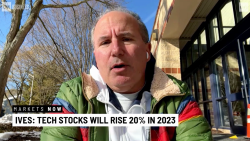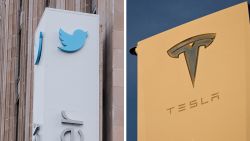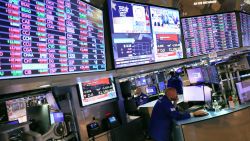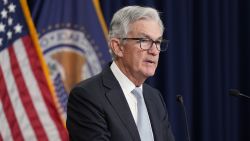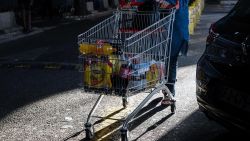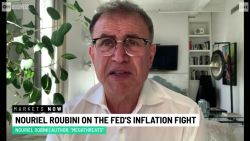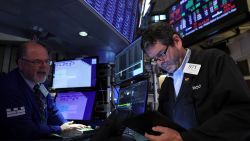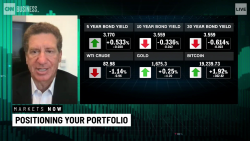A version of this story first appeared in CNN Business’ Before the Bell newsletter. Not a subscriber? You can sign up right here.
What do stretched supply chains, rising prices and the ransomware attack on the Colonial Pipeline have in common? They all stem from risks that investors should have had on their radar.
For months, it’s been clear that snarled supply chains could hold back the post-pandemic recovery and trigger worrisome inflation. Now, that fear is once again coming to the fore, sparking a global sell-off in tech stocks that looks poised to continue on Tuesday.
What’s happening: Nasdaq Composite futures are down sharply in premarket trading. The tech-heavy index tumbled 2.6% on Monday. In Hong Kong, shares of tech giants Baidu and Alibaba dropped 3.5% on Tuesday, while delivery company Meituan’s stock plunged more than 5%.
While economists expect price increases to be temporary, investors remain concerned that rising costs could force central banks to hike interest rates sooner than expected, hurting the investment case for high-growth stocks.
“The [Federal Reserve] has reiterated its intention to stay behind the curve on inflation,” Jean Boivin, head of the BlackRock Investment Institute, told clients Monday, referring to a new Fed policy that would let inflation temporarily rise above its target. “Yet this has been met with some skepticism in markets, against the backdrop of a powerful economic restart.”
It’s clear that Wall Street has been on edge even as stocks have continued to hit record highs, leaving markets vulnerable to any inflation-related triggers. That could come in the form of positive data, for example, that suggests the economy is close to overheating.
Investors have been looking for signs of rising prices for months. Still, the pandemic is stretching supply chains in new ways that could apply further upward pressure to prices.
See here: A record-breaking wave of Covid-19 infections in India threatens to send shockwaves through several important global industries. Should the crisis deepen, it could affect everything from clothing and pharmaceuticals to financial services and global shipping.
So, risks from the pandemic aren’t going away. Then there’s the cyberattack.
Security experts have warned for years that ransomware poses major risks to businesses, so it’s hard to describe the attack on the Colonial Pipeline, which delivers nearly half of the diesel and gasoline consumed on the East Coast, as a black swan event.
But with the disruption raising the specter of $3-a-gallon gasoline in the United States for the first time since 2014, it’s a reminder that any problems with the supply side of the economy have major resonance at a delicate moment for the recovery.
China records its slowest population growth in decades
China’s population grew at its slowest rate in decades in the 10 years prior to 2020, according to census data released on Tuesday — a trend that could pose serious issues for the world’s second-largest economy.
According to China’s National Bureau of Statistics, the population rose by 5.4% over the past decade — or 72 million people — to 1.4 billion people, my CNN Business colleagues Ben Westcott and Eric Cheung report.
The latest data represents an average annual population growth rate of 0.53%. It’s the slowest rate for China since at least the 1960s.
Ning Jizhe, the head of the National Bureau of Statistics, said the falling growth rate was a result of couples putting off having children longer and the rising costs of raising a family.
Why it matters: The figures raise the prospect of a demographic crisis for the world’s most populous nation, with a falling birth rate and rapidly aging work force threatening to curtail its rapid economic growth.
The 2020 census data showed the proportion of the population aged over 65 rose rapidly, from 8.9% in 2010 to 13.5% in 2020.
This increase is a “major headwind” for the Chinese economy, said Yong Cai, a professor of sociology at the University of North Carolina. “[But] China is not alone in this.”
Big picture: Aging populations are a risk for countries around the world, raising the prospect that higher pension costs will kick in just as economic growth begins to lag.
“Because of the aging of our populations, that there will be fewer and fewer persons of working age to support more and more older people,” the Organization for Economic Cooperation and Development has written.
The race for lithium could wipe out this species
Fewer than 40 years after humans discovered Tiehm’s buckwheat, a Nevada plant with yellow flowers, they may drive it to extinction in pursuit of electric vehicles, my CNN Business colleague Matt McFarland reports.
Environmentalists say the benefits of Tiehm’s buckwheat could be vast, but its full significance is unknown. They’re impressed with its ability to thrive where few species can — poor soil that’s full of boron and lithium.
That lithium, a critical mineral in the batteries that power electric vehicles, increasingly has the attention of businesses and governments ramping up sustainability plans. Ioneer, an Australian mining company, has said it’s ready to break ground on a lithium mine later this year on the land where Tiehm’s buckwheat grows. The project has been valued at $1.3 billion.
Step back: The fate of Tiehm’s buckwheat highlights the tradeoffs and tough decisions surrounding green technologies.
Businesses that talk of helping the environment may not be above putting a species at risk of extinction. Ioneer argues that from a big-picture perspective, building its lithium mine is good for the environment. It believes the plant can survive being largely relocated, a claim the environmentalists question.
Patrick Donnelly, Nevada state director of the Center for Biological Diversity, told CNN Business his group is ready for years of fighting in court to protect Tiehm’s buckwheat. He believes society needs to think more critically about the appropriate sites for lithium mines.
“On top of an endangered buckwheat isn’t the right place,” he said. “Biodiversity is what gives us clean air to breath and clean water to drink and it’s what puts food on our plates.”
Up next
Palantir reports results before US markets open. Lemonade follows after the close.
Also today: The latest US Consumer Price Index, a key measure of inflation, posts at 8:30 a.m. ET.
Coming tomorrow: Another look at inflation from the Producer Price Index.




